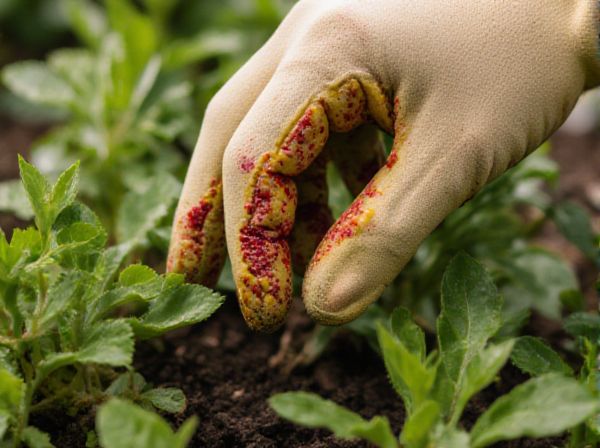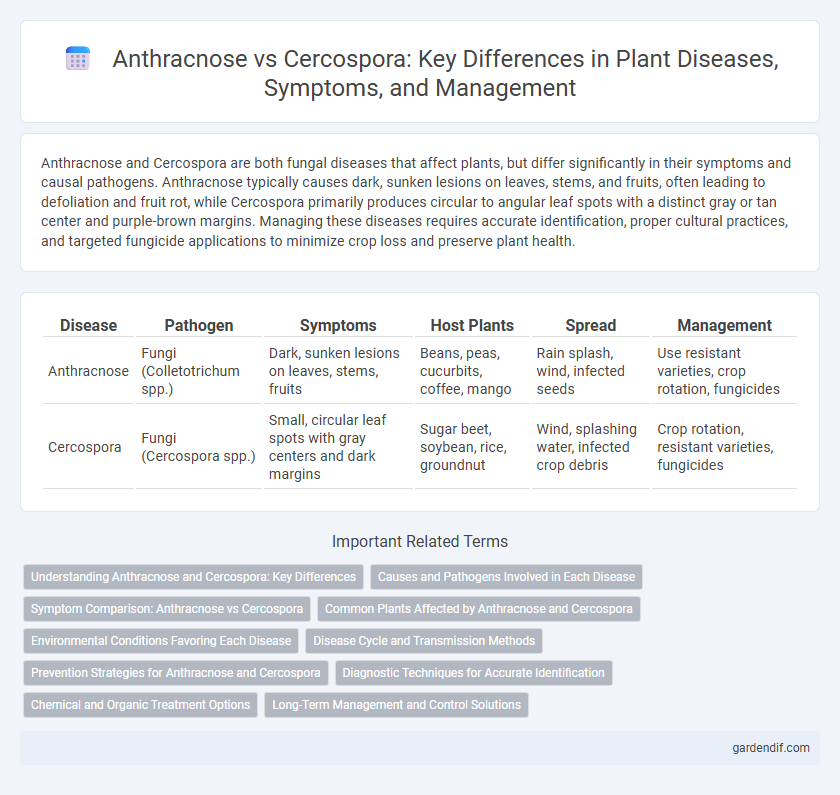
Anthracnose vs Cercospora Illustration
Anthracnose and Cercospora are both fungal diseases that affect plants, but differ significantly in their symptoms and causal pathogens. Anthracnose typically causes dark, sunken lesions on leaves, stems, and fruits, often leading to defoliation and fruit rot, while Cercospora primarily produces circular to angular leaf spots with a distinct gray or tan center and purple-brown margins. Managing these diseases requires accurate identification, proper cultural practices, and targeted fungicide applications to minimize crop loss and preserve plant health.
Table of Comparison
| Disease | Pathogen | Symptoms | Host Plants | Spread | Management |
|---|---|---|---|---|---|
| Anthracnose | Fungi (Colletotrichum spp.) | Dark, sunken lesions on leaves, stems, fruits | Beans, peas, cucurbits, coffee, mango | Rain splash, wind, infected seeds | Use resistant varieties, crop rotation, fungicides |
| Cercospora | Fungi (Cercospora spp.) | Small, circular leaf spots with gray centers and dark margins | Sugar beet, soybean, rice, groundnut | Wind, splashing water, infected crop debris | Crop rotation, resistant varieties, fungicides |
Understanding Anthracnose and Cercospora: Key Differences
Anthracnose and Cercospora are fungal diseases that primarily affect plants, causing leaf spots and defoliation. Anthracnose, caused by Colletotrichum species, typically produces sunken, dark lesions on leaves, stems, or fruit, while Cercospora, caused by Cercospora species, leads to smaller, angular lesions often surrounded by a yellow halo. Effective disease management requires accurate identification, as Anthracnose thrives in warm, wet conditions whereas Cercospora prefers humid environments with moderate temperatures.
Causes and Pathogens Involved in Each Disease
Anthracnose is primarily caused by fungi in the genus Colletotrichum, which infect plant tissues leading to dark, sunken lesions on leaves, stems, and fruits. Cercospora results from Cercospora species fungi that produce leaf spot diseases marked by circular, brown to gray lesions surrounded by reddish or purple halos. Both pathogens thrive in warm, humid environments, but each targets different host plants and tissues, necessitating precise identification for effective disease management.
Symptom Comparison: Anthracnose vs Cercospora
Anthracnose symptoms typically include irregular, dark brown to black leaf spots with a gradual yellow halo, often causing leaf curling and premature defoliation, primarily affecting trees and legumes. Cercospora manifests as small, round to angular spots with a distinctive gray center and reddish-purple border, frequently leading to leaf blight and significant yield loss in crops like sugar beets and soybeans. Both diseases cause leaf discoloration and necrosis but differ in lesion appearance and host specificity, crucial for accurate diagnosis and management.
Common Plants Affected by Anthracnose and Cercospora
Anthracnose primarily affects a wide range of common plants including hardwood trees like maple, oak, and sycamore, as well as vegetables such as beans and cucurbits. Cercospora targets crops like sugar beets, soybeans, and various leafy greens, causing leaf spot diseases that reduce photosynthetic ability. Both fungal pathogens lead to significant yield losses due to leaf spot symptoms, defoliation, and fruit blemishes.
Environmental Conditions Favoring Each Disease
Anthracnose thrives in warm, humid environments with frequent rainfall, promoting the development of dark, sunken lesions on leaves and fruits. Cercospora prefers hot, dry climates with intermittent moisture, leading to distinctive circular leaf spots with gray centers. Both diseases intensify under conditions that favor prolonged leaf wetness and moderate temperatures, impacting crop health significantly.
Disease Cycle and Transmission Methods
Anthracnose is caused by fungi in the Colletotrichum species, with infection cycles involving overwintering in plant debris and spore dispersal through water splash or rain. Cercospora, caused by Cercospora species, survives in crop residues and soil, spreading primarily through airborne conidia and splashing water during wet conditions. Both pathogens undergo multiple infection cycles per growing season, with environmental factors like humidity and temperature playing critical roles in facilitating their transmission and disease development.
Prevention Strategies for Anthracnose and Cercospora
Effective prevention strategies for Anthracnose include crop rotation, resistant cultivars, and timely fungicide applications to reduce fungal spores. Cercospora management emphasizes maintaining proper plant spacing for airflow, removing infected debris, and applying copper-based fungicides. Both diseases benefit from adequate irrigation practices that avoid leaf wetness and promote rapid drying of foliage.
Diagnostic Techniques for Accurate Identification
Accurate identification of Anthracnose and Cercospora relies on microscopic examination of pathogen-specific spore morphology, with Anthracnose typically producing acervuli containing dark, septate conidia, while Cercospora produces conidia that are slender, multiseptate, and often associated with cercosporin toxin production. Molecular diagnostic techniques such as PCR assays targeting species-specific DNA markers provide rapid and precise differentiation, critical for effective disease management. Symptomatic differentiation remains challenging due to overlapping lesion patterns; thus, combining field symptom observation with laboratory-based molecular and microscopic diagnostics enhances accuracy in identifying these fungal pathogens.
Chemical and Organic Treatment Options
Anthracnose and Cercospora diseases can be controlled chemically using fungicides such as chlorothalonil, mancozeb, and copper-based compounds, which provide effective protection when applied at the early stages of infection. Organic treatments include neem oil, baking soda solutions, and biological agents like Bacillus subtilis, which enhance plant resistance and reduce fungal spore viability without harmful residues. Implementing an integrated disease management approach combining chemical and organic treatments improves control efficacy and reduces pathogen resistance in crops affected by Anthracnose and Cercospora.
Long-Term Management and Control Solutions
Long-term management of Anthracnose involves the use of resistant cultivars, crop rotation, and applying fungicides early in the disease cycle to reduce inoculum buildup. Cercospora control requires integrated strategies such as regular monitoring, timely fungicide applications, and proper irrigation practices to minimize leaf wetness that favors pathogen development. Implementing sanitation measures, including removing infected plant debris, helps limit the spread of both pathogens and ensures sustainable disease management.
Anthracnose vs Cercospora Infographic

 gardendif.com
gardendif.com